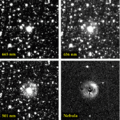Sakurai's Object facts for kids
| Observation data Epoch J2000.0 (ICRS) Equinox J2000.0 (ICRS) |
|
|---|---|
| Constellation | Sagittarius |
| Right ascension | 17h 52m 32.69s |
| Declination | −17° 41′ 08.0″ |
| Apparent magnitude (V) | 10.90 - 21 |
| Characteristics | |
| Spectral type | variable |
| Apparent magnitude (J) | 11.555 ± 0.022 |
| U−B color index | +0.27 |
| B−V color index | +0.81 |
| V−R color index | +0.57 |
| Astrometry | |
| Radial velocity (Rv) | −170 ± 30 km/s |
| Distance | 1800-5000 pc |
| Details | |
| Mass | 0.6 M☉ |
| Luminosity | ~10,000 L☉ |
| Other designations | |
| Database references | |
| SIMBAD | data |
Sakurai's Object, also known as V4334 Sagittarii, is a special star. It is found in the Sagittarius constellation.
Scientists believe it was once a white dwarf. A white dwarf is a very small, dense star. It then swelled up and became a red giant. A red giant is a much larger, cooler star.
This star is now at the center of a planetary nebula. A planetary nebula is a cloud of gas and dust. It forms when a star like Sakurai's Object sheds its outer layers.
Sakurai's Object was first discovered in 1996.
Contents
What Makes Sakurai's Object Special?
Sakurai's Object is unique because of its "born-again" phase. This means it changed from a white dwarf back into a giant star. This change is rare for stars.
The Life Cycle of Sakurai's Object
Most stars like our Sun become red giants. Then they shrink into white dwarfs. But Sakurai's Object did something different. It became a white dwarf, then swelled up again.
Scientists think it will eventually become a helium-rich white dwarf. This means it will be a white dwarf made mostly of helium. This "born-again" process helps scientists understand how stars evolve.
Images for kids
-
Sakurai's Object, by Hilmar Duerbeck, ESO.
See also
 In Spanish: Objeto de Sakurai para niños
In Spanish: Objeto de Sakurai para niños




